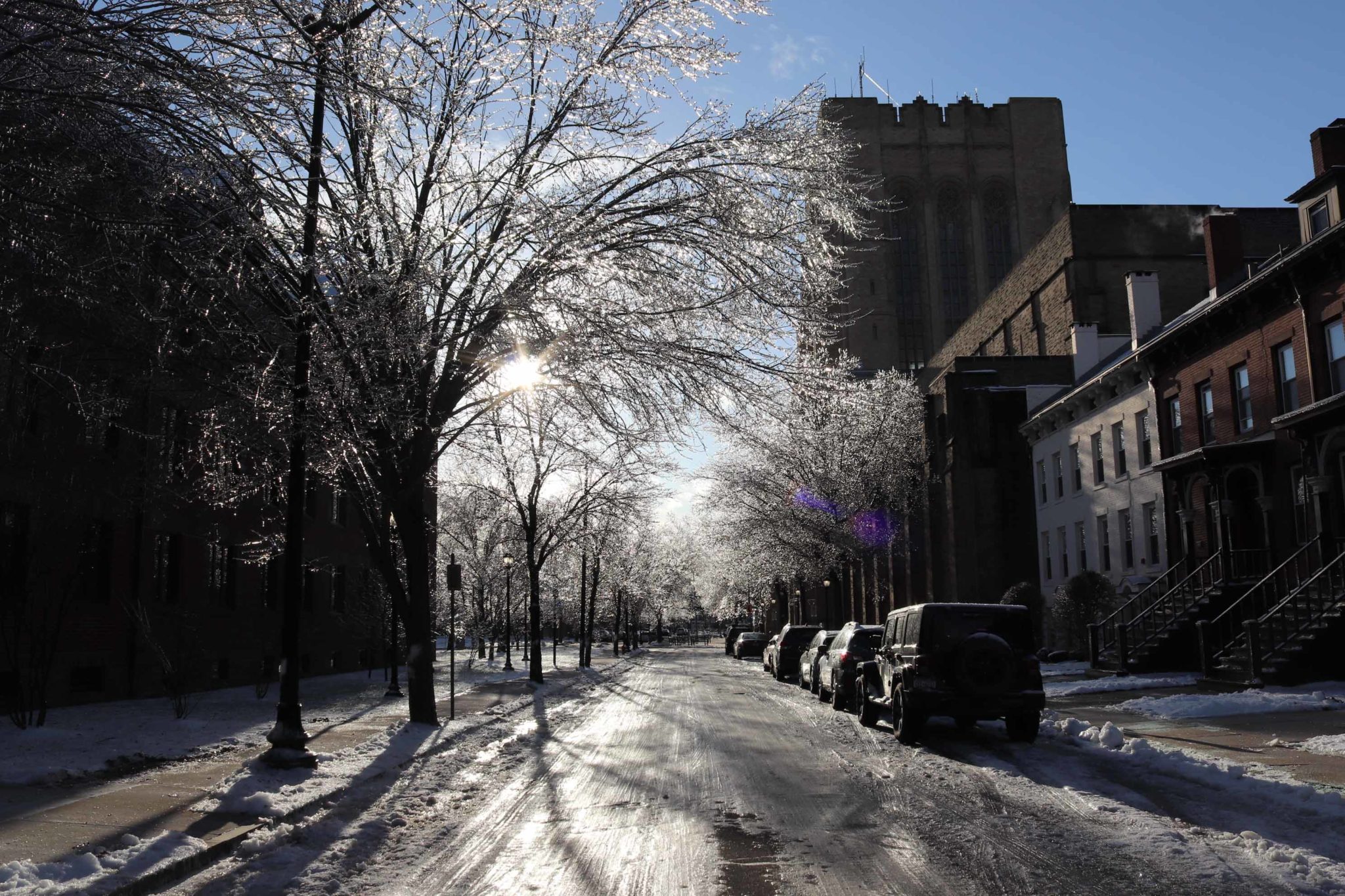
Power outages, fallen trees and icy roads are some of the effects of this weekend’s winter storm, which brought wind chill values as low as 16 below zero fahrenheit to the Elm City. The temperature dipped to a low of 3 and winds gusted as high as 40 mph, according to the National Weather Service.
Monday was declared the coldest day of the winter so far.
“This could be a scary part right now as we think about the freezing, thinking about the wind,” said Connecticut Gov. Ned Lamont SOM ’80 at a winter storm news briefing on Sunday morning. “We are making sure we do everything we can to keep power going, and doing everything we can to make sure those major roads don’t freeze over because that could be dangerous.”
According to Lamont, there were 700 plows working “around the clock” in Connecticut to clear the roads — especially the major roads, such as Interstate I-95 and I-91 — of snow on Sunday before temperatures lowered and the snow turned to black ice. Closer to home, Yale University experienced power outages on Sunday morning in many residential colleges — including Ezra Stiles, Branford and Saybrook, as well as other college buildings.
Luke McKenna ’21 said that his residential college Jonathan Edwards was without power for most of Sunday. The college also lost heating during the power outage, which McKenna said was a concern, but the rooms were fairly well-insulated. Other colleges, including Ezra Stiles and Morse, experienced power outages which only affected the lights — not heating.
“There are students wearing blankets in our dining hall,” Davenport Head of College John Witt ’94 LAW ’99 GRD ’00 told the News.
By 5:42 p.m. Sunday, power had been restored to all of the residential colleges, according to a Sunday evening Yale Alert sent to the University community.
The alert encouraged students to prepare for potential power outages with a “personal go-bag” packed with any medications, personal items and clothes in the “unlikely event” that Yale may need to relocate students. The alert encouraged students to keep their electronic devices as well as a flashlight close by and charged. However, the storm was not as severe as anticipated, and an evacuation did not need to occur on Sunday night.
In an email sent to Stiles students from their head of college office, college administrators warned students of fallen tree limbs due to the ice and heavy snow. The message warned students to avoid walking around campus during the long weekend and proceed with caution if it was necessary to leave the dorms.
Yale students who left University property over the weekend were exposed to the effects of harsh weather conditions. Molly Shapiro ’21 said that as she was driving on Route 10 near Cheshire, she noticed that a large tree had fallen — blocking the entire road. She called 911 to report the road blockage and said that authorities were very responsive and informed her that they received many similar calls throughout the day.
The state held a unified command meeting at the State Emergency Operations Center in Hartford on Sunday morning, according to a tweet from Lamont.
At 3:10 p.m. Saturday, a Yale Alert announced that the City of New Haven issued a parking ban — which prohibits either parking on both sides of the street or on odd sides of the street — in several zones of the city. The email announced that the ban will go into effect at midnight Saturday until further notice due to “expected snow, heavy icing, and extremely cold temperatures.”
However, the scheduled parking ban was cancelled due to “a favorable change in the weather,” as announced in a Yale Alert at 8:45 p.m. the same day, approximately three hours before the ban was to go into effect.
By Monday evening, most New Haven streets were in good shape, despite 2–3 inches of snow over Sunday — followed by sleet, freezing rain and then a sudden, hard freeze on Sunday night. City spokesman Laurence Grotheer told the News that more than 40 plow trucks were on hand to keep New Haven streets passable.
Officials around the city were working to ensure that roads remained safe and constituents were aware of conditions. In addition, an emergency warming center was opened Sunday at 10 p.m. at Hill Regional Career High School to accommodate New Haven residents who may be impacted by the weather. According to City Hall’s Facebook page, the warming center remained open through Monday. Grotheer told the News that the city’s network of shelters and warming centers is operating “just about at its capacity.”
About 1 percent of the state experienced loss of power, according to Lamont. New Haven was particularly hard hit, with over 5,000 New Haven outages reported by the time of Lamont’s press briefing on Sunday. But as of 3 p.m. Monday, only 159 city residents remained without power due to 21 remaining tree-on-wires episodes, according to Grotheer.
“Ice-laden tree branches falling onto power lines presented the biggest challenge,” Grotheer said. “Crews responded to more than 150 of these incidents, working safely, quickly and effectively to restore power to those who had lost it.”
When Marianne Ayala ’20 tried to visit Walgreens on York Street at around 10:30 a.m. Sunday, the store had no power and was completely dark. The employees lined up behind the entrance of the store and told customers that they had to pay in cash while the power was out.
At approximately 7 p.m. on Sunday, The United Illuminating Company — a Connecticut-based electricity distribution company that serves over 58,000 New Haven customers — reported that 2,764 of its New Haven customers were currently experiencing outages. However, on Monday evening, only 46 United Illuminating Company customers in New Haven were experiencing outages.
Connecticut saw its coldest recorded temperature in 1941 and 1943 with a temperature of minus 32.
Sammy Westfall | sammy.westfall@yale.edu
Interested in getting more news about New Haven? Join our newsletter!







